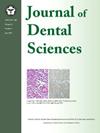利用口内照片建立和评估基于深度学习的牙齿磨损严重程度分级系统
IF 3.4
3区 医学
Q1 DENTISTRY, ORAL SURGERY & MEDICINE
引用次数: 0
摘要
背景/目的人工智能(AI)以其较高的准确性和效率可以辅助医疗诊断。本研究旨在开发一种基于深度学习的口腔内照片自动确定牙齿磨损程度的诊断系统。材料与方法本研究包括388张口腔内照片。首先使用Mask R-CNN架构建立了一个牙齿分割模型,该模型结合了U-Net和SGE注意机制。随后,将分割模型输出的2774张单独的牙齿图像纳入分类任务,按6.0:2.0:2.0的比例标记并随机分为训练集、验证集和测试集。构建了一个基于掩模机制优化的视觉变换模型,用于TW度分类。使用准确性、精密度、召回率和f1评分指标对模型进行评估。计算人工智能分析所需的时间。结果牙齿分割模型的准确率为0.95。分类任务的平均正确率为0.93,精密度为0.91,查全率为0.88,f1得分为0.89。f1得分在不同等级之间存在差异(0级为0.97,1级为0.90,2级为0.88,3级为0.82)。不同表面之间的准确性无显著差异。人工智能系统将单个牙齿表面分级所需的时间减少到0.07秒,而临床医生需要2.67秒。结论本系统对口腔内照片测定TW度具有较高的准确性和效率。它可以帮助临床医生做出治疗决策,帮助患者进行自我评估和疾病随访。本文章由计算机程序翻译,如有差异,请以英文原文为准。
Establishment and evaluation of a deep learning-based tooth wear severity grading system using intraoral photographs
Background/purpose
Artificial intelligence (AI) can assist in medical diagnosis owing to its high accuracy and efficiency. This study aimed to develop a diagnostic system for automatically determining the degree of tooth wear (TW) using intraoral photographs with deep learning.
Materials and methods
The study included 388 intraoral photographs. A tooth segmentation model was first established using the Mask R-CNN architecture, which incorporated U-Net and SGE attention mechanisms. Subsequently, 2774 individual tooth images output from the segmentation model were included into the classification task, labeled and randomized into training, validation, and test sets with 6.0:2.0:2.0 ratio. A vision transformer model optimized using a mask mechanism was constructed for TW degree classification. The models were evaluated using the accuracy, precision, recall, and F1-score metrics. The time required for AI analysis was calculated.
Results
The accuracy of the tooth segmentation model was 0.95. The average accuracy, precision, recall, and F1-score in the classification task were 0.93, 0.91, 0.88, and 0.89, respectively. The F1-score differed in different grades (0.97 for grade 0, 0.90 for grade 1, 0.88 for grade 2, and 0.82 for grade 3). No significant difference was observed in the accuracy between different surfaces. The AI system reduced the time required to grade an individual tooth surface to 0.07 s, compared to the 2.67 s required by clinicians.
Conclusion
The developed system provides superior accuracy and efficiency in determining TW degree using intraoral photographs. It might assist clinicians in the decision-making for TW treatment and help patients perform self-assessments and disease follow-ups.
求助全文
通过发布文献求助,成功后即可免费获取论文全文。
去求助
来源期刊

Journal of Dental Sciences
医学-牙科与口腔外科
CiteScore
5.10
自引率
14.30%
发文量
348
审稿时长
6 days
期刊介绍:
he Journal of Dental Sciences (JDS), published quarterly, is the official and open access publication of the Association for Dental Sciences of the Republic of China (ADS-ROC). The precedent journal of the JDS is the Chinese Dental Journal (CDJ) which had already been covered by MEDLINE in 1988. As the CDJ continued to prove its importance in the region, the ADS-ROC decided to move to the international community by publishing an English journal. Hence, the birth of the JDS in 2006. The JDS is indexed in the SCI Expanded since 2008. It is also indexed in Scopus, and EMCare, ScienceDirect, SIIC Data Bases.
The topics covered by the JDS include all fields of basic and clinical dentistry. Some manuscripts focusing on the study of certain endemic diseases such as dental caries and periodontal diseases in particular regions of any country as well as oral pre-cancers, oral cancers, and oral submucous fibrosis related to betel nut chewing habit are also considered for publication. Besides, the JDS also publishes articles about the efficacy of a new treatment modality on oral verrucous hyperplasia or early oral squamous cell carcinoma.
 求助内容:
求助内容: 应助结果提醒方式:
应助结果提醒方式:


